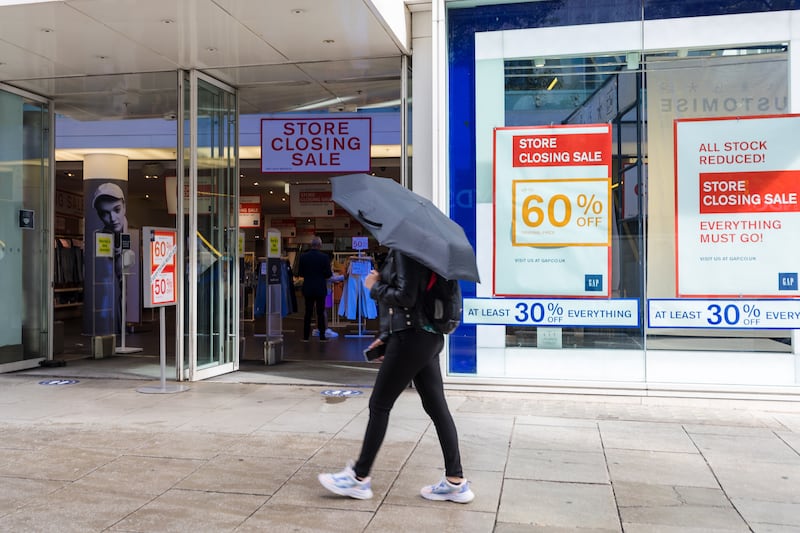British retail sales dropped unexpectedly in July, falling at the fastest pace since the economy was in lockdown in January, signalling that the country’s recovery was losing momentum.
Retail sales volume dropped 2.5 per cent last month following a 0.2 per cent gain in June, according to the Office for National Statistics, as bad weather after the Euro 2020 football tournament kept shoppers away from high streets.
“Following the Euro 2020 related boost in June, retail sales fell in July to their lowest level since shops reopened in April, but still remain well above pre-pandemic levels,” said Jonathan Athow, deputy national statistician for economic statistics at the ONS.
“Heavy rainfall at the start of July hit fuel sales, which dipped for the first time since February.”
Food sales fell 1.5 per cent as further lifting of hospitality restrictions meant consumers had more opportunities to spend outside the shops, while non-food stores reported a fall of 4.4 per cent.
Fuel sales also fell for the first time since February, again partly due to the wet weather deterring motorists from hitting the road.
Other non-food stores, including chemists, toy stores and sports shops, reported a 10.1 per cent drop in sales, the first since February. However, despite the slowdown, retail sales are still 5.8 per cent above February 2020's pre-pandemic levels.
“The holiday season was a bit of a washout for sales in July. The miserable weather kept a lid on everything from BBQs at home to road-trips and shopping for a holiday wardrobe,” said Sarah Coles, personal finance analyst at Hargreaves Lansdown.
“Meanwhile, efforts to entertain ourselves with new technology at home were stymied by shortages. Sales are still higher than usual for the time of year, as we make up for the lost shopping months at the start of the year. However, they have pulled back since the peak in April.”
One bright spot is that food sales are still up 4.9 per cent from their pre-pandemic levels in February last year.
Helen Dickinson, chief Executive of the British Retail Consortium, said “there are headwinds looming on the horizon” for retailers in the second half of the year.
“Challenges in global shipping and the shortage of UK lorry drivers are creating some disruption for consumers and additional costs for retailers,” she said.
“In October, the UK will introduce new checks on products of animal origin being imported from the EU, adding more costs to the system. Government must take action on these issues, increasing the number of HGV driving tests taking place and ensuring new EU-GB documentation checks are as light touch as possible.”
The dismal retail sales in July may also be a sign of renewed caution among shoppers after a rise in Covid-19 cases in the country.
Online sales rose to 27.9 per cent of total spending after falling to a pandemic low in June.
The figures, along with a weaker inflation reading earlier this week of 2 per cent, ease pressure on the Bank of England to pare back its stimulus programme.
The central bank has warned that consumer price increases may surge to double its 2 per cent target by the end of this year, but a slower pace of spending reduces that risk.
“With households still sitting on a large pile of savings and the much talked about pent-up demand still far from being fully satiated, consumer activity can probably still be relied upon to provide a solid foundation for UK growth going forward. Unfortunately it is looking as if this foundation will not be as high as previously hoped for,” said Stuart Cole, chief macroeconomist at stockbroker Equiti Capital.
“Taken in conjunction with yesterday’s softer CPI release, the numbers will ease the pressure that had been starting to grow on the BoE to begin dialling back its stimulus programme and we can probably now expect it to wait until a clearer picture of underlying activity emerges following the removal of much of the government’s support programmes next month before taking any material action.”
A separate report showed UK government borrowing in the first four months of the fiscal year was running at just over half the level of a year earlier with the economy returning to normality as Covid restrictions were eased.
The budget deficit stood at £78 billion ($106.7bn) between April and July, compared with £139.7bn in the same period of 2020, when the economy was being hammered by the effects of the first lockdown.
“Our recovery from the pandemic is well under way,” said Chancellor of the Exchequer Rishi Sunak. “But the last 18 months have had a huge impact on our economy and public finances, and many risks remain.”
Ruth Gregory, senior UK economist at Capital Economics, said that while the public borrowing figures were good news, the slump in retail sales added to other evidence indicating that the economic recovery slowed in July.
“These data mean that after contributing to the 1 per cent month-on-month rise in GDP in June, retail sales will have knocked 0.15 percentage points off GDP in July. So while we still expect GDP to return to its February 2020 peak in October, the risk is that the virus and the “pingdemic” caused GDP to take longer to reach that landmark,” Ms Gregory said.







